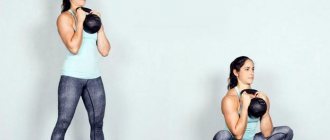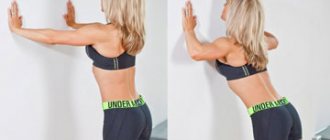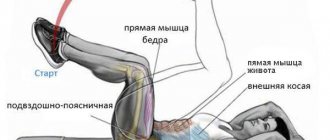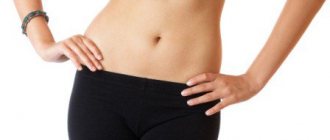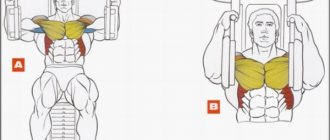Crunches, or abdominal crunches, are the most popular exercise for training the abdominal muscles. And one of the most common in general. The classic version does not require any equipment; you can practice anywhere. With the proper approach, the result will definitely be obvious - spectacular abs for men and a flat stomach for girls. Thanks to this material, you will learn how to do abdominal crunches effectively. Go!
How to pump up six-pack abs on a fitball
Most fitness exercises are based on mandatory training of the abdominal muscles because they are involved in most movements of the human body and are responsible for balancing all parts. But pumping up these muscles is not enough for some.
After all, many, both boys and girls, strive to achieve a beautiful belly and six-pack abs on it.
The truth is there is a problem: many people want it, but not everyone achieves it. What is the reason? The first reason is that those six-pack abs don't just require more exercise. And using special exercises. The second main reason: unbalanced diet. With a combination of nutrition and exercise, it is quite possible to get six-pack belly fat in a month.
Many guys believe that a gymnastic ball is more suitable for girls and that it is unrealistic to pump up abs on a fitball. Let's try to break these stereotypes.
On topic: Abdominal exercises set of exercises
With these simple three exercises on a fitball, accessible even to beginners, you can get six-pack abs in a short time. This will help you not only have a beautiful belly. After all, strong abdominal muscles are a guarantee against future possible injuries in training or in life.
What it is?
Crunches for the press are called twisting, that is, reducing the distance between the chest and pelvis by flexing the spine. Thanks to these actions, the abdominal area and oblique muscles are worked out. Regular exercise will allow you to get those coveted six-pack abs over time.
The main effect of crunches is due to strong contractions of the abdominal muscles. Thanks to the dynamic and regular execution of the exercise, a powerful metabolic press is created, which stimulates the hypertrophy of certain areas. So, gradually the relief is outlined and becomes more pronounced.
Additionally, it is worth noting that crunches promote blood flow to the deep muscle layers, fascia and the spine itself, which helps speed up the transport of nutrients that help maintain their youth and health.
Crunches allow you to strengthen body tissues and prepare them for significant stress.
Abs on a fitball with three simple exercises
1. Leg Curl on a Fitness Ball at the Knees
Take the position of the ankles of your feet on the fitball, with your hands resting with your palms on the floor, as for the well-known push-up exercise.
The exercise is simple. You bend your knees, maintaining body balance. At the same time, the ball rolls towards the body. Finish when your knees touch your chest as shown in the picture. After this, slowly roll the ball back, straightening your legs. Perform 15 reps
2. Twisting (crunches) on a fitness ball
Lie down on an exercise ball with your back slightly arched and your knees bent. If using dumbbells or kettlebells, hold the weights across your chest with both hands. Bend at the waist to lift your upper torso until you feel extreme tension in your abdominal muscles. Perform 15 repetitions.
3.Plank on fitball
Everyone these days knows what a plank exercise is. Some people know that the number of types of planks reaches several dozen. So here it is. This exercise is one of the variations of the elbow plank.
Execution: Place your elbows on a Swiss ball (or fitness ball). Keep your back straight and your feet wide for greater stability. But if you feel confident in yourself, to make it more difficult, you can close your legs or reduce the distance between them as much as possible.
We engage the press and hold the position for 30-60 seconds or until you can maintain the form.
Try to regularly perform workouts twice every day and then you will be able to answer the question: is it possible to pump up your abs on a fitball?
Source
Useful tips
To make crunches easier and more effective, consider the following recommendations:
- In women, the curve in the lower part of the spine is greater than in men, which is due to the structure of the pelvis. In addition, fat deposits give additional lift to the lower back. In this regard, when performing crunches, it is worth placing a small pillow, a regular bolster or a rolled towel under the bend of the back in the lower part of the spine. Men should also not neglect this in order to promote contraction of the abdominal muscles and prevent back injuries, such as intervertebral discs.
- There is no need to increase the range of motion by completely lifting the torso, because in this case the main load will fall on the lumbar region.
- The key point in performing twists is the placement of the hands. The greatest load is created when abducted behind the head, medium - when crossed on the chest, light - when pulled forward.
- To increase the load, you can place a barbell disc on your chest or move it behind your head.
- You cannot move your head back and look up, as this will cause an extra arch in your back. You need to slightly tilt your head forward and look at your stomach. Of course, you should not lower your head too low, as this can cause severe strain on your neck.
If you feel pain in the neck while performing crunches, you need to interrupt the workout. If the pain does not go away within a few days, you will have to consult a physical therapist or chiropractor.
Fitball exercises, abdominal exercises at home
Every girl wants to have beautiful abs, this is understandable, because we expose our tummy on the beach, in the summer, wearing a short T-shirt, and any tight dress will definitely emphasize it.
How to restore (or acquire) abs after the birth of a baby?
Firstly, this is a reasonable diet (more on this in other articles), and secondly, various ointments, creams, scrubs (they tighten the skin well). And thirdly, of course, abdominal exercises. Where would we be without them?
In this article I want to look in detail at abdominal exercises using a fitball (ball).
Why fitball
- Are you bored with regular abdominal exercises?
- diastasis;
- the level of physical fitness does not allow you to fully pump up your abs with standard exercises;
- or vice versa, you want to complicate regular exercises.
Using a ball will not only add variety to your training, but will also significantly increase the efficiency of each movement.
Moreover, abdominal exercises on a fitball are suitable for absolutely all people, regardless of age or level of fitness, so purchasing a ball will please the whole family.
What are the advantages of fitball?
Among the main advantages of the ball, it is worth noting not only the change in the nature of the load, but also the ability to concentrate the load specifically on the abdominal muscles.
If we talk about the main advantage for all exercises on the ball, then it is worth highlighting the difficulty of maintaining balance. As you know, in order to maintain a certain body position and not fall, the body uses stabilizer muscles.
This is precisely the reason for the great popularity of fitballs, training with which is significantly superior to conventional work with exercise machines or without weights. If we talk about the benefits of fitballs in general, it should be noted:
- Versatility
- you can perform not only abdominal exercises, but also push-ups, hyperextensions and other movements. In doing so, the ball can improve the effectiveness of each of them; - Safety
- exercises on a fitball are recognized as absolutely safe and are often recommended for both advanced athletes and those recovering from injuries; - Working with the ball significantly reduces the compression load
on the vertebrae and allows you to train for hernias, protrusions and other pathologies, calmly strengthening the muscle corset; - Development
of coordination and flexibility.
Video: crunches for women
The following video clearly demonstrates a set of different types of crunches that will help a girl work out her abdominal muscles:
If there are no contraindications, you can safely do crunches. They are useful not only for the abdominal muscles, but also for the whole body. To achieve excellent results and avoid injury, you should start training by mastering the classical technique. Loads need to be increased as the body becomes trained. Regular training will not only allow you to work out your abs perfectly, but will also help burn belly fat.
In the eighties and nineties, almost everyone in the fitness industry not only recommended crunches, but put them first, raving about their effectiveness. I remember many years ago reading a book by Dr. Frederick Hatfield in which he wrote, “Crunches are the Cadillac of abdominal exercises.” I'd rather compare them to a Mercedes, but you get the idea - he thought crunches were the ultimate car designed for abdominal muscles. but is it? Let's figure it out.
Crunches, as explained by experts in those days, are an essential exercise for the abs, since the movement of crunches is to reduce the distance between the chest and pelvis, which is literally the main function of the rectus abdominis muscles, also known as spinal flexion.
Crunches have also been praised for the fact that they are not a full sit-up, which also activates the hip flexors, but rather a partial crunch that "isolates" the abdominal muscles. Then everything changed and the “Anti-Crunch Era” began.
Over the first few years of the new millennium, there has been a revolution in the idea of crunches and ab training in general. What happened? The fitness industry is notoriously fickle and prone to sudden changes of opinion, even among respected experts, and we know all too well of clients' love of switching to "the latest and greatest." In this case, “core training” became the new trend, and with the beginning of this craze, the era of crunches came to an end. Planks have become the new favorite exercise and tons of books have appeared about core training without a single mention of crunches (or sit-ups). Wait, more to come. It is not enough to simply replace one most popular exercise with another; authorities must certainly criticize the old one. Suddenly crunches weren't just inferior, they were "bad."
Ab crunches with a fitball
It is quite obvious that the top movement for the upper abdomen, both with and without a ball, will be crunches.
However, when combined with an inflatable apparatus, the exercise can feel completely different. It often happens that athletes who can easily do 20–30 crunches have difficulty doing 12 on a gymnastic ball.
The fact is that the muscles work differently, the concentration of tension is maintained throughout the entire approach, and more muscles are activated.
On topic: Workout for abdominal muscles
All this ultimately requires a lot of energy and forces the muscles to adapt to new conditions, responding to them by growing and strengthening the fibers.
So, let's look at the main details and features of exercises using a ball. The fulcrum should be the lower back.
- Press your lower back firmly into the exercise ball to maintain balance (a properly sized exercise ball should be sandwiched between your shoulder blades and buttocks at the lowest point).
- Feet should be placed to the sides, thighs should be parallel to the floor.
- Your hands should be placed behind your head; this is the ideal position for crunches.
At first, working at full amplitude may seem difficult to you, so you can achieve this gradually.
It is also worth considering that due to the switching off of the lower back and greater load on the abdominal muscles, it is better to do fewer repetitions. The abs will already be quite loaded, so you need to finish the set right before the onset of muscle failure. There is an alternative twist option:
- Lie with your back on the floor, place your hands behind your head. Bend your knees at a right angle and place them on the ball;
- Slowly raise your shoulder blades and stretch your chin towards your knees, trying to bring your body as close as possible;
- Holding the ball will involve your lower abs and thighs, so you need to perform the movements slowly and without jerking, so that the upper abdomen also receives the load.
What muscles work?
To understand exactly how crunches work, you should pay attention to the muscles that work during their execution:
- Direct . The relief of the press depends on it. It starts from the middle of the sternum and extends to the pubis. Many people believe that the abs are divided into two parts - upper and lower. However, this is incorrect because anatomically it is a single rectus muscle, so there is no division.
- External oblique . The muscle fibers have a medial location (from top to bottom). They start from the side of the sternum and are responsible for the formation of a slender waist. To work the muscle more actively, it is necessary to supplement classic crunches with a rotation of the body. In general, it always works when the internal oblique muscle is worked.
- Internal oblique . Like the previous muscle, it is responsible for the formation of a thin waist. Its fibers are located in the lumbosternal and inguinal regions of the abdomen. Lateral crunches promote effective muscle development.
- Transverse . This muscle is used to exhale deeply. Its fibers are located transversely in the lower abdomen.
There are different variations of crunches. If you master their technique correctly and perform them comprehensively, you can quickly get the desired abs.
Exercises for the lower abs
Training with a fitball allows you to make some lower abdominal movements incredibly effective. Even leg pull-ups in this situation can rival the best exercises for the lower abdomen.
Bringing your legs to your stomach
The technique of this movement combines two exercises at once, for which a towel or napkins are usually used (for sliding on the floor).
When performing, your hands should rest on the floor, and your feet should be placed on a fitball. The body should remain straight in the starting position. Next, slowly roll the ball as close to your chest as possible, twisting your body and bending your knees.
The need for additional balance will further increase the effectiveness of this exercise.
Contraindications
Despite the benefits of abdominal training, you need to be careful. Some exercises, such as hanging crunches, are not recommended for those suffering from high intraocular pressure or intracranial hypertension. Ignoring the recommendation may make the problem worse.
In general, before starting training, you should consult your doctor. Especially for those who have problems with blood vessels, heart, spine, and respiratory system. You should not load your abs during pregnancy.
Lying leg raises with a gymnastic ball
Everything is much simpler here. The technique doesn't change much, except that your legs should wrap around the ball.
Moreover, this must be done at the level of the equator, that is, in the middle. This position of the legs, above the floor level, will allow you to constantly maintain tension at the lowest point.
Next, simply lift your legs up with the ball until they are perpendicular to the floor (a right angle between the body and the thigh). After this, at the same slow pace, return the ball to its original position.
It is also worth considering that this exercise works well on the inner thighs, which usually lag behind the outer quadriceps.
Plank with ball
Using an inflatable projectile can significantly improve the effectiveness of the bar.
This is due to the fact that under normal conditions, during a plank, it is necessary to maintain balance in one plane (vertically), and when working with the ball, in two (vertically and horizontally).
To perform the movement, place your outstretched arms on the floor and place your feet on a fitball (the fulcrum should be slightly at ankle level, not on your toes).
Stretch your body into one straight line and hold for as long as possible. You can also perform the plank in a different form, but this technique will be less effective and complex. To do this, simply change the fulcrum, resting your toes on the floor and your hands on the fitball.
Bend your elbows and place them on the ball so that it does not slip out from under you while doing the plank.
This happens due to the fact that under normal conditions, during a plank, it is necessary to maintain balance in one plane (vertically), and when working with the ball, in two (vertically and horizontally).
To do this, simply change the fulcrum, resting your toes on the floor and your hands on the fitball. Bend your elbows and place them on the ball so that it does not slip out from under you while doing the plank.
Exercises for oblique abdominal muscles
It is this part of the abdominal muscles that receives the maximum benefit from using the ball, as it allows you to:
- Lateral crunches (fitball under your side);
- Cross crunches (with the right shoulder tilted towards the left knee and vice versa);
- Side plank.
Moreover, any movement with a ball, from push-ups to planks or crunches, will more engage the obliques, which help maintain balance.
With a fitball, pumping up powerful obliques will be much easier and faster than using conventional exercises on the floor or bench.
Source
The main thing is technique
How to do abdominal crunches correctly? The technique, if strictly followed, is responsible for safety. You need to follow a number of simple recommendations:
- The range of movements should not be high. The spine should bend approximately 30 degrees.
- If the exercise is performed on the floor, then only the head and shoulders remain elevated, while the lumbar region should be pressed tightly to the surface.
- Repetitions should be performed smoothly, without sudden movements.
- Also important is the frequency and number of repetitions, which are usually calculated individually.



